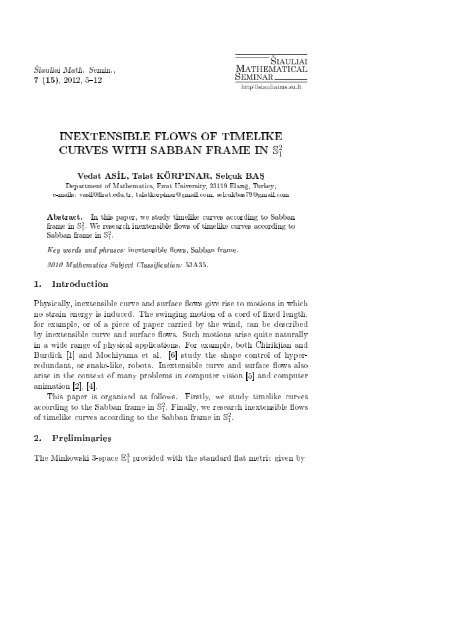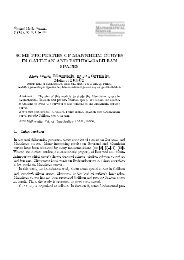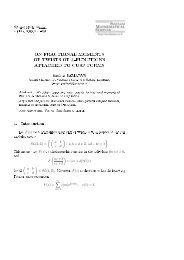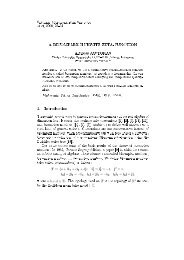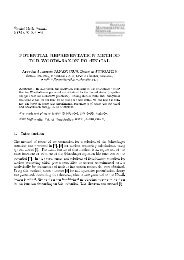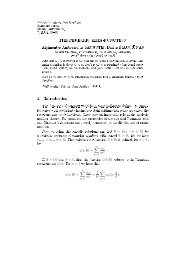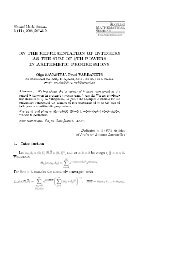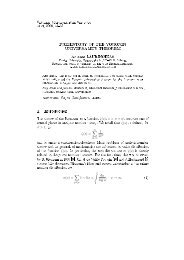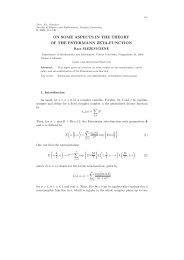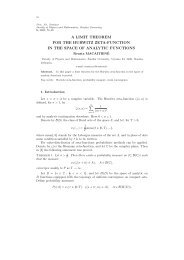inextensible flows of timelike curves with sabban frame in s2
inextensible flows of timelike curves with sabban frame in s2
inextensible flows of timelike curves with sabban frame in s2
You also want an ePaper? Increase the reach of your titles
YUMPU automatically turns print PDFs into web optimized ePapers that Google loves.
’iauliai Math. Sem<strong>in</strong>.,7 (15), 2012, 512INEXTENSIBLE FLOWS OF TIMELIKECURVES WITH SABBAN FRAME IN S 2 1Vedat AS L, Talat KÖRPINAR, Selçuk BA“Department <strong>of</strong> Mathematics, Frat University, 23119 Elaz§, Turkey;e-mails: vasil@rat.edu.tr, talatkorp<strong>in</strong>ar@gmail.com, selcukbas79@gmail.comAbstract. In this paper, we study <strong>timelike</strong> <strong>curves</strong> accord<strong>in</strong>g to Sabban<strong>frame</strong> <strong>in</strong> S 2 1. We research <strong><strong>in</strong>extensible</strong> ows <strong>of</strong> <strong>timelike</strong> <strong>curves</strong> accord<strong>in</strong>g toSabban <strong>frame</strong> <strong>in</strong> S 2 1.Key words and phrases: <strong><strong>in</strong>extensible</strong> ows, Sabban <strong>frame</strong>.2010 Mathematics Subject Classication: 53A35.1. IntroductionPhysically, <strong><strong>in</strong>extensible</strong> curve and surface ows give rise to motions <strong>in</strong> whichno stra<strong>in</strong> energy is <strong>in</strong>duced. The sw<strong>in</strong>g<strong>in</strong>g motion <strong>of</strong> a cord <strong>of</strong> xed length,for example, or <strong>of</strong> a piece <strong>of</strong> paper carried by the w<strong>in</strong>d, can be describedby <strong><strong>in</strong>extensible</strong> curve and surface ows. Such motions arise quite naturally<strong>in</strong> a wide range <strong>of</strong> physical applications. For example, both Chirikjian andBurdick [1] and Mochiyama et al. [6] study the shape control <strong>of</strong> hyperredundant,or snake-like, robots. Inextensible curve and surface ows alsoarise <strong>in</strong> the context <strong>of</strong> many problems <strong>in</strong> computer vision [5] and computeranimation [2], [4].This paper is organized as follows. Firstly, we study <strong>timelike</strong> <strong>curves</strong>accord<strong>in</strong>g to the Sabban <strong>frame</strong> <strong>in</strong> S 2 1 . F<strong>in</strong>ally, we research <strong><strong>in</strong>extensible</strong> ows<strong>of</strong> <strong>timelike</strong> <strong>curves</strong> accord<strong>in</strong>g to the Sabban <strong>frame</strong> <strong>in</strong> S 2 1 .2. Prelim<strong>in</strong>ariesThe M<strong>in</strong>kowski 3-space E 3 1 provided <strong>with</strong> the standard at metric given by
6 V. Asil, T. Körp<strong>in</strong>ar, S. Ba³⟨, ⟩ = −dx 2 1 + dx 2 2 + dx 2 3,where (x 1 , x 2 , x 3 ) is a rectangular coord<strong>in</strong>ate system <strong>of</strong> E 3 1 . Recall that, thenorm <strong>of</strong> an arbitrary vector a ∈ E 3 1 is given by ∥a∥ = √ ⟨a, a⟩. γ is called aunit speed curve if velocity vector v <strong>of</strong> γ satises ∥a∥ = 1.Denote by {T, N, B} the mov<strong>in</strong>g Frenet-Serret <strong>frame</strong> along the <strong>timelike</strong>curve γ <strong>in</strong> the space E 3 1 . For an arbitrary <strong>timelike</strong> curve γ <strong>with</strong> rst and secondcurvature, κ and τ <strong>in</strong> the space E 3 1 , the follow<strong>in</strong>g Frenet-Serret formulaeare givenwhereT ′ = κN,N ′ = κT + τB,B ′ = −τN,⟨T, T⟩ = −1, ⟨N, N⟩ = ⟨B, B⟩ = 1,⟨T, N⟩ = ⟨T, B⟩ = ⟨N, B⟩ = 0.Here, the curvature functions are dened by κ = κ(s) = ∥T ′ (s)∥ and τ(s) =− ⟨N, B ′ ⟩.Torsion <strong>of</strong> the <strong>timelike</strong> curve γ is given by the aid <strong>of</strong> the mixed productτ = [γ′ , γ ′′ , γ ′′′ ]κ 2 .Now we give a new <strong>frame</strong> dierent from the Frenet <strong>frame</strong>. Let α : I → S 2 1be an unit speed spherical <strong>timelike</strong> curve. We denote σ as the arc-lengthparameter <strong>of</strong> α. Let us denote t (σ) = α ′ (σ), and we call t (σ) a unit tangentvector <strong>of</strong> α. We now set a vector s (σ) = α (σ) × t (σ) along α. This <strong>frame</strong>is called the Sabban <strong>frame</strong> <strong>of</strong> α on S 2 1 . Then we have the follow<strong>in</strong>g sphericalFrenet-Serret formulae <strong>of</strong> α [3]:α ′ = t,t ′ = α + κ g s,s ′ = κ g t,where κ g is the geodesic curvature <strong>of</strong> the <strong>timelike</strong> curve α on the S 2 1 , andg (t, t) = −1, g (α, α) = 1, g (s, s) = 1,g (t, α) = g (t, s) = g (α, s) = 0.
Inextensible ows <strong>of</strong> <strong>timelike</strong> <strong>curves</strong>... 73. Inextensible ows <strong>of</strong> <strong>timelike</strong> <strong>curves</strong> accord<strong>in</strong>g tothe Sabban <strong>frame</strong> <strong>in</strong> S 2 1Let α (u, t) is a one-parameter family <strong>of</strong> smooth <strong>timelike</strong> <strong>curves</strong> <strong>in</strong> S 2 1 .The arc length <strong>of</strong> α is given byσ(u) = u ∂α0 ∣ ∂u ∣ du,whereThe operator ∂∂σ∣⟨ ∂α∣∣∣ ∂α∣ ∂u ∣ = ∂u , ∂α ⟩∣ ∣∣∣1/2.∂uis given <strong>in</strong> terms <strong>of</strong> u by∂∂σ = 1 ∂ν ∂u ,where v =∂α∣ ∂u ∣ , and the arc length parameter is dσ = vdu.Any ow <strong>of</strong> α can be represented asLet the arc length variation be∂α∂t = fS 1 α + f S 2 t + f S 3 s. (3.1)σ(u, t) = u 0vdu.In the S 2 1 , the requirement that the curve not be subject to any elongationor compression can be expressed by the conditionfor all u ∈ [0, l] .∂∂t σ(u, t) = u ∂v0 du = 0 (3.2)∂tDef<strong>in</strong>ition 3.1. The ow ∂α∂t <strong>in</strong> S2 1 is said to be <strong><strong>in</strong>extensible</strong> if∂∂t∂α∣ ∂u ∣ = 0.
8 V. Asil, T. Körp<strong>in</strong>ar, S. Ba³Lemma 3.2. Let ∂α∂t = fS 1 α + fS 2 t + fS 3 s be a smooth ow <strong>of</strong> the <strong>timelike</strong> curveα. The ow is <strong><strong>in</strong>extensible</strong> if and only if∂v∂t + ∂fS 2∂u = −fS 1 v − f S 3 vκ g . (3.3)Pro<strong>of</strong>. Suppose that ∂α be a smooth ow <strong>of</strong> the <strong>timelike</strong> curve α. Us<strong>in</strong>g∂tdenition <strong>of</strong> α, we have⟨ ∂αv 2 =∂u , ∂α ⟩. (3.4)∂uBy dierentiat<strong>in</strong>g <strong>of</strong> the formula (??), we get2v ∂v∂t = ∂ ⟨ ∂α∂t ∂u , ∂α ⟩.∂uOn the other hand, chang<strong>in</strong>g ∂∂u and ∂ , we have∂tv ∂v ⟨ ⟩∂α∂t = ∂u , ∂∂u (∂α ∂t ) .From (3.1), we obta<strong>in</strong>v ∂v ⟨ ∂α∂t = ∂u , ∂ (fS∂u 1 α + f S 2 t + f S 3 s )⟩ .By the Sabban formula, we have⟨ ( ) () ( ) ⟩∂v ∂fS∂t = t, 1∂u + fS 2 v α + f S 1 v + ∂fS 2∂fS∂u + fS 3 vκ g t + 3∂u + fS 2 vκ g s .Mak<strong>in</strong>g necessary calculations, from above equation we obta<strong>in</strong> (3.3) whichproves the lemma.Theorem 3.3. Let ∂α∂t = fS 1 α + fS 2 t + fS 3 s be a smooth ow <strong>of</strong> the <strong>timelike</strong>curve α. The ow is <strong><strong>in</strong>extensible</strong> if and only if∂f S 2∂u = −fS 3 vκ g − f S 1 v.
Inextensible ows <strong>of</strong> <strong>timelike</strong> <strong>curves</strong>... 9Pro<strong>of</strong>. Assume that ∂α∂t∂∂t σ(u, t) = u ∂v0∂t du = u 0is <strong><strong>in</strong>extensible</strong>. From (3.2), we have(−f S 1 v − ∂fS 2∂u − fS 3 vκ g)du = 0. (3.5)Substitut<strong>in</strong>g (3.3) <strong>in</strong> (3.5) completes the pro<strong>of</strong> <strong>of</strong> the theorem.Now we restrict ourselves to arc length parametrized <strong>curves</strong>. That is,v = 1 and the local coord<strong>in</strong>ate u corresponds to the curve arc length σ. Werequire the follow<strong>in</strong>g lemma.Lemma 3.4. The follow<strong>in</strong>g relations hold( )∂t ∂fS= 1∂t ∂σ + fS 2 α +(∂α ∂fS= 1∂t ∂σ + fS 2where ψ =∂s∂t⟨ ⟩ ∂α∂t , s .=)t + ψs,( ∂fS3∂σ + fS 2 κ g)t − ψα,Pro<strong>of</strong>. Us<strong>in</strong>g denition <strong>of</strong> α, we have∂t∂t = ( ∂fS1∂σ + fS 2( ∂fS3∂σ + fS 2 κ g)s,∂t∂t = ∂ ∂α∂t ∂σ = ∂∂σ (fS 1 α + f S 2 t + f S 3 s).Us<strong>in</strong>g the Sabban equations, we nd that)α +Substitut<strong>in</strong>g (3.3) <strong>in</strong> (3.6), we get∂t∂t = ( ∂fS1∂σ + fS 2(f S 1 + ∂fS 2∂σ + fS 3 κ g)t +)α +( ∂fS3∂σ + fS 2 κ g)s.Now dierentiate the Sabban <strong>frame</strong> by t:∂f S ⟨1∂σ + fS 2 + t, ∂α ⟩= 0,∂t∂f S ⟨3∂σ + fS 2 κ g + t, ∂s ⟩= 0,∂t⟨ψ + α, ∂s ⟩= 0.∂t( ∂fS3∂σ + fS 2 κ g)s. (3.6)
10 V. Asil, T. Körp<strong>in</strong>ar, S. Ba³Then, a straightforward computation us<strong>in</strong>g above system gives( )∂α ∂fS= 1∂t ∂σ + fS 2 t + ψs,( )∂s ∂fS= 3∂t ∂σ + fS 2 κ g t − ψα,⟨ ⟩ ∂αwhere ψ =∂t , s . Thus, we obta<strong>in</strong> the assertion <strong>of</strong> the theorem.The follow<strong>in</strong>g theorem states the conditions on the curvature and torsionfor the ow to be <strong><strong>in</strong>extensible</strong>.Theorem 3.5. Let ∂α be <strong><strong>in</strong>extensible</strong>. Then the system <strong>of</strong> partial dierential∂tequationsholds.∂κ g∂σ + ψ = ∂2 f S 3∂σ 2 + ∂ ∂s (fS 2 κ g ),( ∂ 2 f S )1κ g ψ = −∂σ 2 + ∂fS 2∂σPro<strong>of</strong>. Assume that ∂α is <strong><strong>in</strong>extensible</strong>. Then∂t∂ ∂t= ∂ [( ) ( ) ]∂fS1∂fS∂σ ∂t ∂σ ∂σ + fS 2 α + 3∂σ + fS 2 κ g s( ∂ 2 f S ) ( ) ( )1=∂σ 2 + ∂fS 2 ∂fSα + [ 1∂fS∂σ ∂σ + fS 2 +κ 3 g∂σ + fS 2 κ g ]t( ∂ 2 f S 3+∂σ 2 + ∂ )∂σ (fS 2 κ g ) s.From the Sabban <strong>frame</strong>, we have∂ ∂t∂t ∂σ = ∂ ∂t (α+κ gs)=[ ∂κg∂σ + ψ ]s +[ ( ) ( ) ]∂fS1∂fS∂σ + fS 2 + κ 3 g∂σ + fS 2 κ g t − κ g ψα.Therefore,∂κ g∂σ + ψ = ∂2 f S 3∂σ 2 + ∂∂σ (fS 2 κ g )
Inextensible ows <strong>of</strong> <strong>timelike</strong> <strong>curves</strong>... 11andThus, we obta<strong>in</strong> the theorem.( ∂ 2 f S )1κ g ψ = −∂σ 2 + ∂fS 2.∂σCorollary 3.6.( ) ∂fSκ 1 g∂σ + fS 2 = − ∂fS 3∂σ − fS 2 κ g − ∂ψ∂σ .Pro<strong>of</strong>. Similarly, we have∂ ∂s∂σ ∂t= ∂ [( ) ]∂fS3∂σ ∂σ + fS 2 κ g t − ψα[ ( ∂ 2 f S 3=∂σ + ∂) ( )( )fS ∂fS∂σ 2 κ g − ψ t+κ 3 g∂σ + fS 2 κ g s[ ( )∂fS+ 3∂σ + fS 2 κ g − ∂ψ ] ]α .∂σOn the other hand, a straightforward computation gives∂ ∂s∂t ∂σ = ∂ ∂t (κ gt)= ∂κ g∂t t + κ g[( ) ( ) ]∂fS1∂fS∂σ + fS 2 α + 3∂σ + fS 2 κ g s .Comb<strong>in</strong><strong>in</strong>g these equalities, we obta<strong>in</strong> the corollary.In the light <strong>of</strong> Theorem 3.5, we express the follow<strong>in</strong>g corollaries <strong>with</strong>outpro<strong>of</strong>s.Corollary 3.7.Corollary 3.8.∂κ g∂t = ∂2 f S 3∂σ + ∂ ( )fS∂σ 2 κ g − ψ.∂f S 3∂σ + fS 2 κ g − ∂ψ∂σ = ∂fS 1∂σ + fS 2 .References[1] G. Chirikjian, J. Burdick, A modal approach to hyper-redundant manipulatork<strong>in</strong>ematics, IEEE Trans. Robot. Autom., 10, 343354 (1994).
12 V. Asil, T. Körp<strong>in</strong>ar, S. Ba³[2] M. Desbrun, M.-P. Cani-Gascuel, Active implicit surface for animation, <strong>in</strong>:Proc. Graphics Interface-Canadian Inf. Process. Soc., 143150, 1998.[3] S. Izumiya, D. H. Pei, T. Sano, E. Torii, Evolutes <strong>of</strong> hyperbolic plane <strong>curves</strong>,Acta Math. S<strong>in</strong>ica (English Series), 20 (3), 543550 (2004).[4] D. Y. Kwon , F. C. Park, D. P. Chi, Inextensible ows <strong>of</strong> <strong>curves</strong> and developablesurfaces, Appl. Math. Lett., 18, 11561162 (2005).[5] H. Q. Lu, J. S. Todhunter, T. W. Sze, Congruence conditions for nonplanardevelopable surfaces and their application to surface recognition, CVGIP,Image Underst., 56, 265285 (1993).[6] H. Mochiyama, E. Shimemura, H. Kobayashi, Shape control <strong>of</strong> manipulators<strong>with</strong> hyper degrees <strong>of</strong> freedom, Int. J. Robot. Res., 18, 584600 (1999).Received26 January 2012


